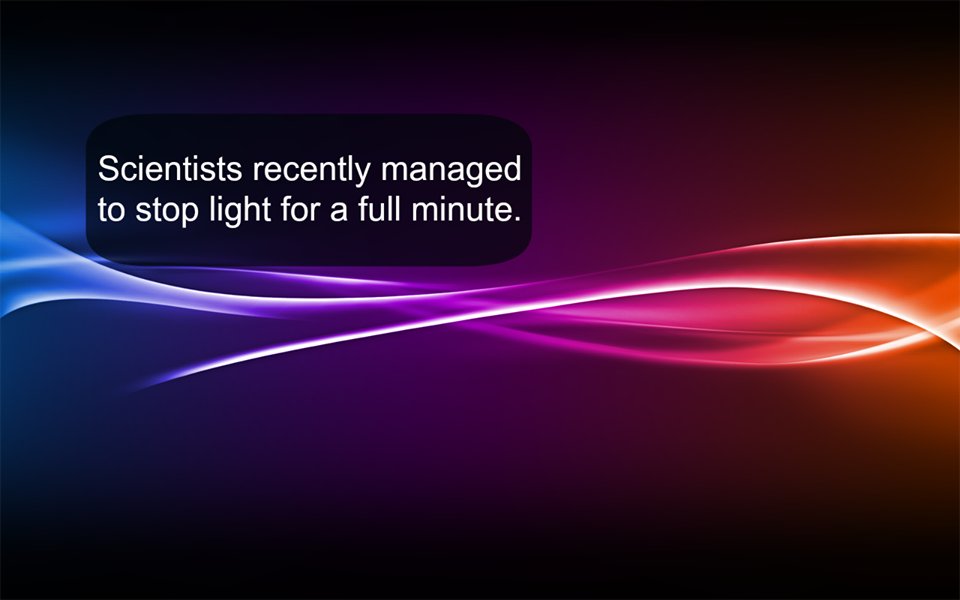

Most of us probably know a few basic facts about light: nothing can travel faster than it, it comes in forms that we can’t see (such as x-ray and infrared), it can give you a nasty sunburn or a super cute tan (which will inevitably make you look like old leather), and it can be slowed down. If you didn’t know the last one, allow me to explain.
The speed of light is a constant. It travels at an amazing 186,282 miles per second (299,791km/sec). However, this speed only applies in a perfect vacuum where light will not encounter any other atoms. In a non-vacuum (which exists pretty much everywhere), bits of light smash into other objects. These objects absorb the photon and then re-emit it. In this respect, the slowing of light is an illusion. The photons still travel from at the same speed, but they make a few stops along the way as they are absorbed and refracted by various atoms. And light is absorbed and emitted more slowly through certain substances. For example, diamond makes light travel from A to B significantly slower.
But we can use these principles to essentially stop light. In all likeliness, many of you have already heard about the scientists in Germany who stopped light for a full minute. I’d like to offer a breakdown of how they accomplished this feat.
To begin with, the scientists took an opaque crystal (something that light is not able to penetrate) and fired lasers into it. This caused the quantum states of atoms within the crystal to become disturbed. Ultimately, the scientists were able to make it so that a specific frequency of light could pass through this previously opaque object by altering the crystal in such a say so that the atoms within it had two quantum states.
Next, the researchers shot a laser beam (which corresponded to the specific frequency) through the newly transparent region. Then they turned off the laser beam that was altering the quantum states of the atoms within the crystal. This made the material once more opaque. The result of this was that the second laser beam was halted within the material. The beam was held in place for a whole minute. They were also able to store and retrieve an image using the same technique.
![(a) APS/H. de Riedmatten; (b) G. Heinze et al. [1] Figure 1: (a) Energy-level scheme for EIT experiments: two ground states (|g〉 and |s〉) are connected to one excited state (|e〉) by an optical transition. To reach the EIT condition, the frequency difference between the input and control beams must be equal to the splitting between |g〉 and |s〉. (c) Output pulse energy and storage efficiency as a function of the storage time, as measured by Heinze et al. [1] for three coherence times (T2) obtained under different sequences of radio frequency pulses. The inset shows a three-stripe image retrieved from the memory after different storage times.](https://futurism.com/wp-content/uploads/2013/09/b9cc1bd41950d791.png?strip=all&quality=85&w=216&h=300)
Figure 1: (a) Energy-level scheme for EIT experiments: two ground states (|g〉 and |s〉) are connected to one excited state (|e〉) by an optical transition. To reach the EIT condition, the frequency difference between the input and control beams must be equal to the splitting between |g〉 and |s〉. (c) Output pulse energy and storage efficiency as a function of the storage time, as measured by Heinze et al. [1] for three coherence times (T2) obtained under different sequences of radio frequency pulses. The inset shows a three-stripe image retrieved from the memory after different storage times.
Of course, things are not quite this simple. For starters, the crystal that was frozen to less than negative 450 degrees Fahrenheit (-267C). But the aforementioned is a basic breakdown of the technique. For those interested in more technical information, see this source. Here, I will offer a brief passage which conveys the specifics:
“Light can be slowed down to the point that it comes to a halt: by switching off the control beam when the light is within the sample, the photons can be converted into collective atomic spin excitations (so called spin waves). The spin waves can be stored in the atoms for as long as the coherence between the two spin levels survives, before being converted back into light by turning on the control pulse again. The scheme thus allows the coherent storage and retrieval of light. How long can the storage time be? Since the light is stored in atomic coherences, the limit is given by T2, quantifying the lifetime of the coherence between the two relevant atomic spin states (how long the two spin states can remain in a coherent superposition).”